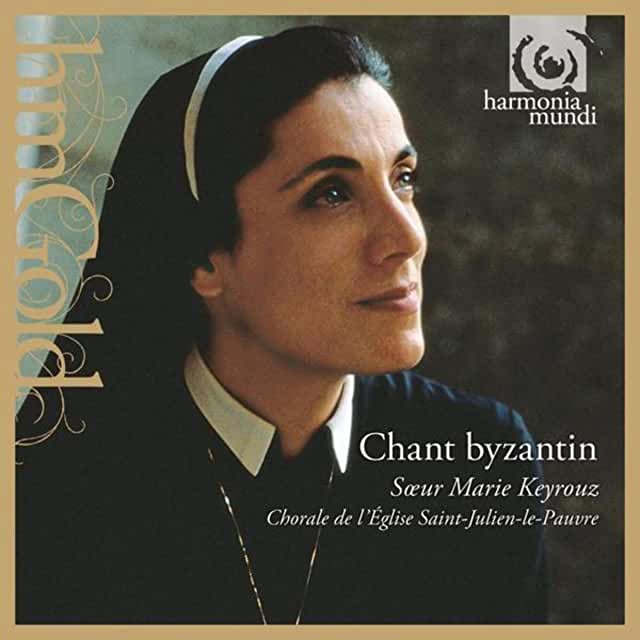| 25,00 ą |
-
Alleluiae 01:45
Sister Marie Keyrouz – Alleluia
-
Alleluia - Version Grecque 01:14
Sister Marie Keyrouz– Alleluia - Version Grecque
-
Alleluia - Version Arabe 01:16
Sister Marie Keyrouz – Alleluia - Version Arabe
-
Priere de Marie-Madeleine 03:17
Sister Marie Keyrouz – Priere de Marie-Madeleine
-
L'Apostikhon de l'Office - Iqbalni 03:38
Sister Marie Keyrouz – L'Apostikhon de l'Office - Iqbalni
-
Kinonikon - Inna Yousof 01:09
Sister Marie Keyrouz – Kinonikon - Inna Yousof
-
Tropaire des Matines - Alyawma-Ullika 03:04
Sister Marie Keyrouz – Tropaire des Matines - Alyawma-Ullika
-
14e Antienne de l'Office - izoi 00:51
Sister Marie Keyrouz – 14e Antienne de l'Office - izoi
-
Extraits du Canon de Samedi 1 - Exion 01:03
Sister Marie Keyrouz – Extraits du Canon de Samedi 1 - Exion
-
Extraits du Canon de Samedi 2 00:36
Sister Marie Keyrouz – Extraits du Canon de Samedi 2
-
Hymne a la Sainte Vierge 03:11
Sister Marie Keyrouz – Hymne a la Sainte Vierge
-
Christos Anesti 00:51
Sister Marie Keyrouz – Cristos Anesti
-
Antoumoul-ladhin 01:45
Sister Marie Keyrouz – Antoumoul-ladhin
-
Inna-l-Malak 02:02
Sister Marie Keyrouz – Inna-l-Malak
They are at the center of the liturgical year. The faithful prepare themselves for it during the forty days of Lent, while the forty days after Easter are a period of joy.
All of the liturgical offices are preceded by the triple Cristo Anesti, Christ has risen?. Each day in Holy Week has its own particular theme. Monday evokes one of the veterotestamentary figures of Christ, Joseph, sold by his brothers.
Tuesday mentions the Last Judgement and the barren fig-tree. Wednesday presents the faithful with the example of the repentant prostitute, Lord, the woman who had fallen into a great many sins? : mary Magdalen in contrast with the cupidity and despair of Judas.
Maundy Thursday refers, above all, to the Last Supper, At thy mystic Supper?, the washing of the disciples' feet, explaining the sacramental significance of the Gospel of St. John.
The Paschal character of the Eucharist is stressed at the same time as the love for one's neighbour, two dimensions of the same mystery. The office of the day intimately links the three themes of the Last Supper, the washing of the feet, the institution of the Holy Eucharist, and the betrayal of Judas.
The latter is the principal subject at Vespers when we experience the great event of the Crucifixion of Christ, especially in the chanting of the 14th Antiphon, This day he is hanged upon the gallows tree, who has suspended the earth over the waters ?.
In the Byzantine rite the office of Matins on Holy saturday (Epitaphios) is a quiet meditation on the mystery of Christ asleep in the tomb, awaiting the hour of his descent into hell and his Resurection.
They are prolonged lamentations which the Holy Women are supposed to have sung around the tomb.
A deeply inspired work entirely suffused with thelogy. In spite of the tears shed by the Theotokos, the Mother of God, and by the Church on the death of the son and bridegroom, a note of joy shines through everywhere : the anticipation of the triumph of the Resurection and the redemption of mankind.
The chants of Easter Matins are the most splendid in all the Byzantine liturgy, overflowing with the exultant joy of the resurection, a joy that is carried to the heights of spiritual rapture.
It is reflected in the joyful sparkling of the candles that all of the faithful have lit from the candle of the celebrant and hold in their hands : the eloquent symbol of the new life communicated by the risen Christ.
Above all, it shines out in the magnificence of the texts that express and intensify it, in the Paschal tropiary, repeated a hundred times, Christ is risen ?, Ye who have been baptized in Christ, ye who have arrayed Christ ?, and finally in the appeals of the angel to her who is full of grace to rejoice, and to the new Jerusalem to shine forth in the Resurection of Christ.
And what a reason to let ourselves be seized by this boundless joy!
Sister Marie Keyrouz
- ←
- 1
- →
